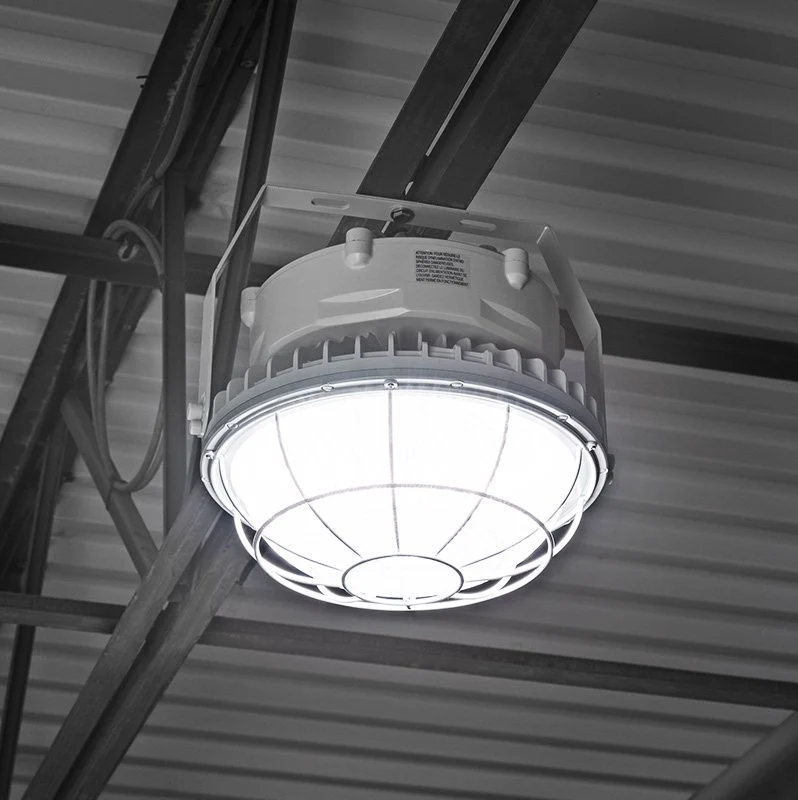Explosion-proof lighting is an essential solution for environments where flammable gases, dust, or vapours are present. These specialized lighting fixtures are designed to prevent ignition and reduce the risk of explosions in high-risk areas, ensuring both safety and efficiency in industries such as oil and gas, chemical plants, mining, and pharmaceuticals.
In this guide, we’ll delve into what explosion-proof lighting is, why it’s crucial for hazardous environments, and how to select the best fixtures for your needs.
What is Explosion-Proof Lighting?
Explosion-proof lighting refers to lighting fixtures that are specifically engineered to withstand and contain internal explosions without igniting the external environment. These lights are built with sealed enclosures and specialized construction that prevent sparks or heat from escaping. They are typically used in areas with the potential for combustible materials, such as flammable gases, vapours, or dust.
Why is Explosion-Proof Lighting Necessary?
In hazardous environments, even a small spark can lead to catastrophic consequences. Explosion-proof lighting is essential for the following reasons:
- Preventing Ignition: Explosion-proof lights ensure that sparks or overheating within the light fixtures do not ignite flammable substances.
- Protecting Workers: These lights are designed to operate safely in environments where worker safety is a primary concern.
- Compliance with Regulations: Many industries require compliance with safety standards, such as the ATEX or NEC, which dictate the use of explosion-proof lighting in specific hazardous zones.
- Maintaining Productivity: Explosion-proof lighting provides reliable illumination in environments where normal lighting solutions are too risky, ensuring uninterrupted operations.
Key Features of Explosion-Proof Lighting
Explosion-proof lighting fixtures are built with certain features to ensure safety and efficiency in dangerous environments. Some of the most important features include:
- Sealed Enclosures: Explosion-proof lights are constructed with robust, airtight enclosures to prevent any internal sparks or heat from escaping.
- Impact Resistance: These lights are made from tough, shatter-resistant materials that can withstand harsh impacts or vibrations in industrial settings.
- Corrosion Resistance: Since many hazardous environments are prone to exposure to chemicals, salts, or moisture, explosion-proof lighting fixtures are often made with corrosion-resistant materials like stainless steel.
- Heat Dissipation: Explosion-proof lights are designed to dissipate heat efficiently, preventing overheating that could lead to ignition.
- IP Ratings: Explosion-proof lights often come with high Ingress Protection (IP) ratings, indicating their ability to resist dust, moisture, and other environmental factors.
Types of Explosion-Proof Lighting
- LED Explosion-Proof Lights:
LED explosion-proof lighting is increasingly popular due to its energy efficiency, long lifespan, and low maintenance. These lights provide bright, consistent illumination while consuming less power and reducing heat output, making them ideal for hazardous areas. - Fluorescent Explosion-Proof Lights:
Fluorescent explosion-proof lights are still commonly used in many industries, offering bright lighting and energy savings. While they aren’t as durable or energy-efficient as LEDs, they are a cost-effective solution for some hazardous areas. - Halogen Explosion-Proof Lights:
Halogen explosion-proof lighting offers high brightness levels and is typically used for tasks that require focused lighting, such as inspection or work in dark areas. However, they consume more power and generate more heat compared to LED options. - Flood Lights and High Bay Lights:
Explosion-proof flood lights and high bay lights are used for larger areas that require broad, even illumination, such as warehouses, factories, or outdoor facilities. These lights ensure that hazardous areas remain illuminated while reducing the risk of ignition.
Explosion-Proof Lighting Standards and Compliance
To ensure safety and performance, explosion-proof lighting fixtures must comply with specific industry standards. Two key standards include:
- ATEX (Atmosphère Explosible): This European standard defines the requirements for equipment used in explosive atmospheres. ATEX-approved lighting is essential in industries like oil, gas, and mining.
- NEC (National Electrical Code): This U.S. standard specifies the electrical requirements for hazardous locations and includes specifications for explosion-proof lighting in explosive environments.
Compliance with these standards ensures that explosion-proof lighting fixtures are safe to use in designated hazardous zones and are tested to prevent any risk of ignition.
How to Choose Explosion-Proof Lighting for Your Facility
When selecting explosion-proof lighting, it’s important to consider several factors:
- Hazardous Area Classification: Determine the specific hazardous zone in which the lighting will be used. This could be Zone 0, 1, or 2 (for gas) or Zone 20, 21, or 22 (for dust). The lighting should be appropriate for the classification of the area.
- Light Output and Efficiency: Choose a lighting solution that offers adequate illumination for the area, taking into account factors such as the size of the space, the nature of the work being done, and energy efficiency.
- Durability and Material: Select lighting fixtures made of materials that can withstand environmental factors like moisture, chemicals, and extreme temperatures.
- Ease of Installation and Maintenance: Opt for explosion-proof lighting that is easy to install and maintain, with easy access for bulb replacement and regular inspections.
- Cost vs. Value: While explosion-proof lights tend to be more expensive than standard lighting, their reliability, safety, and long-term cost savings make them a worthy investment for hazardous environments.
Explosion Proof
Ensuring Safety in Hazardous Environments
A hazardous area (also known as an «Ex area,» «explosive atmosphere,» or «hazardous location») is any location where flammable liquids, vapours, gases, or combustible dusts and fibres are likely to be present in quantities sufficient to cause a fire or explosion. The classification of these areas depends on the likelihood and duration of the presence of these explosive substances.
Explosion Proof
Illumination Designed for Extreme Resilience and Security
Distinct from explosion-proof lighting (which focuses on preventing ignition in flammable atmospheres), blast-proof lights are fundamentally about mechanical resilience against violent physical events. They are the epitome of robust engineering, designed to maintain functionality in the most hostile and unpredictable conditions. For sectors where operational continuity, safety, and security are paramount, investing in blast-proof lighting solutions is a non-negotiable safeguard.
Explosion Proof
BAF9011 Explosion-Proof LED Luminaire
Heavy-Duty & Corrosion-Proof: Constructed from high-strength die-cast aluminum alloy with an anti-corrosion (WF2) electrostatic paint finish, providing superior resistance to high temperatures, aging, and harsh chemicals.
Certified for Hazardous Locations: Fully certified with an Exd IIC T6 rating, making it safe for use in explosive gas environments classified as Zone 1 and Zone 2.
High-Efficiency Illumination: Delivers an exceptional efficacy of 140 lm/W using high-performance LUMILEDS chips, ensuring maximum brightness while minimizing energy costs. A high CRI of >80Ra provides clear, true-to-colour light.








